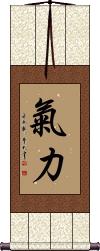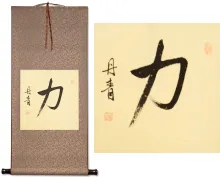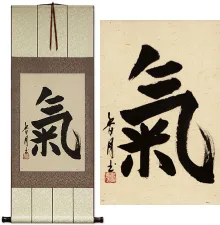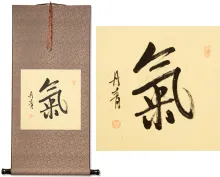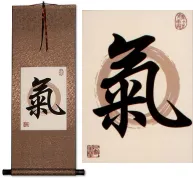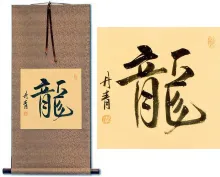Many custom options...
And formats...

Not what you want?
Try other similar-meaning words, fewer words, or just one word.
Feel free to email me with your request. If it's easy, I'll translate it for free and add it to this database of calligraphy for you.
Spiritual Power in Chinese / Japanese...
Buy a Spiritual Power calligraphy wall scroll here!
Personalize your custom “Spiritual Power” project by clicking the button next to your favorite “Spiritual Power” title below...
Strength / Vigor / Energy
Physical Strength
氣力 can mean any of the words in the title above, and in some contexts, can also mean effort, will-power, or talent.
This refers mostly to physical strength (as opposed to mental or spiritual).
![]() In modern Japan, they use a simplified first character for this word. If you want to order this title with that special Japanese version, click on the character to the right instead of the button above.
In modern Japan, they use a simplified first character for this word. If you want to order this title with that special Japanese version, click on the character to the right instead of the button above.
Psychic Power
This in-stock artwork might be what you are looking for, and ships right away...
Gallery Price: $65.00
Your Price: $39.77
Gallery Price: $31.00
Your Price: $16.88
Gallery Price: $300.00
Your Price: $109.88
Gallery Price: $72.00
Your Price: $39.88
Gallery Price: $90.00
Your Price: $49.88
Gallery Price: $65.00
Your Price: $39.88
Gallery Price: $90.00
Your Price: $49.88
Starting at: $28.88
Gallery Price: $108.00
Your Price: $59.88
Gallery Price: $198.00
Your Price: $109.88
Gallery Price: $106.00
Your Price: $58.88
Gallery Price: $65.00
Your Price: $39.88
Gallery Price: $65.00
Your Price: $39.88
Not the results for spiritual power that you were looking for?
Below are some entries from our dictionary that may match your spiritual power search...
| Characters If shown, 2nd row is Simp. Chinese |
Pronunciation Romanization |
Simple Dictionary Definition | ||||||||||||||||||||||||||||||||||||||||||||||||||||||||||||
神 see styles |
shén shen2 shen miwa みわ |
More info & calligraphy: Spirit / Spiritual Essence(1) spirit; psyche; (2) (See 神・かみ・1) god; deity; divinity; kami; (female given name) Miwa Inscrutable spiritual powers, or power; a spirit; a deva, god, or divinity; the human spirit; divine, spiritual, supernatural. |
||||||||||||||||||||||||||||||||||||||||||||||||||||||||||||
瑜伽 see styles |
yú jiā yu2 jia1 yü chia yuga ゆが |
More info & calligraphy: Yoga{Buddh} (See ヨーガ) yoga; (surname) Yuga yoga; also 瑜誐; 遊迦; a yoke, yoking, union, especially an ecstatic union of the individual soul with a divine being, or spirit, also of the individual soul with the universal soul. The method requires the mutual response or relation of 境, 行, 理, 果 and 機; i.e. (1) state, or environment, referred to mind; (2) action, or mode of practice; (3) right principle; (4) results in enlightenment; (5) motivity, i.e. practical application in saving others. Also the mutual relation of hand, mouth, and mind referring to manifestation, incantation, and mental operation; these are known as 瑜伽三密, the three esoteric (means) of Yoga. The older practice of meditation as a means of obtaining spiritual or magical power was distorted in Tantrism to exorcism, sorcery, and juggling in general. |
||||||||||||||||||||||||||||||||||||||||||||||||||||||||||||
三身 see styles |
sān shēn san1 shen1 san shen sanmi さんみ |
{Buddh} trikaya (three bodies of the Buddha); (surname) Sanmi trikāya. 三寶身 The threefold body or nature of a Buddha, i.e. the 法, 報, and 化身, or dharmakāya, sambhogakāya, and nirmāṇakāya. The three are defined as 自性, 受用, and 變化, the Buddha-body per se, or in its essential nature; his body of bliss, which he "receives" for his own "use" and enjoyment; and his body of transformation, by which he can appear in any form; i.e. spiritual, or essential; glorified; revealed. While the doctrine of the trikāya is a Mahāyāna concept, it partly results from the Hīnayāna idealization of the earthly Buddha with his thirty-two signs, eighty physical marks, clairvoyance, clairaudience, holiness, purity, wisdom, pity, etc. Mahāyāna, however, proceeded to conceive of Buddha as the Universal, the All, with infinity of forms, yet above all our concepts of unity or diversity. To every Buddha Mahāyāna attributed a three-fold body: that of essential Buddha; that of joy or enjoyment of the fruits of his past saving labours; that of power to transform himself at will to any shape for omnipresent salvation of those who need him. The trinity finds different methods of expression, e.g. Vairocana is entitled 法身, the embodiment of the Law, shining everywhere, enlightening all; Locana is 報身; c.f. 三賓, the embodiment of purity and bliss; Śākyamuni is 化身 or Buddha revealed. In the esoteric sect they are 法 Vairocana, 報 Amitābha, and 化 Śākyamuni. The 三賓 are also 法 dharma, 報 saṅgha, 化 buddha. Nevertheless, the three are considered as a trinity, the three being essentially one, each in the other. (1) 法身 Dharmakāya in its earliest conception was that of the body of the dharma, or truth, as preached by Śākyamuni; later it became his mind or soul in contrast with his material body. In Mādhyamika, the dharmakāya was the only reality, i.e. the void, or the immateria1, the ground of all phenomena; in other words, the 眞如 the tathāgatagarbha, the bhūtatathatā. According to the Huayan (Kegon) School it is the 理or noumenon, while the other two are氣or phenomenal aspects. "For the Vijñānavāda... the body of the law as highest reality is the void intelligence, whose infection (saṃkleҫa) results in the process of birth and death, whilst its purification brings about Nirvāṇa, or its restoration to its primitive transparence" (Keith). The "body of the law is the true reality of everything". Nevertheless, in Mahāyāna every Buddha has his own 法身; e.g. in the dharmakāya aspect we have the designation Amitābha, who in his saṃbhogakāya aspect is styled Amitāyus. (2) 報身Sambhogakāya, a Buddha's reward body, or body of enjoyment of the merits he attained as a bodhisattva; in other words, a Buddha in glory in his heaven. This is the form of Buddha as an object of worship. It is defined in two aspects, (a) 自受用身 for his own bliss, and (b) 他受用身 for the sake of others, revealing himself in his glory to bodhisattvas, enlightening and inspiring them. By wisdom a Buddha's dharmakāya is attained, by bodhisattva-merits his saṃbhogakāya. Not only has every Buddha all the three bodies or aspects, but as all men are of the same essence, or nature, as Buddhas, they are therefore potential Buddhas and are in and of the trikāya. Moreover, trikāya is not divided, for a Buddha in his 化身 is still one with his 法身 and 報身, all three bodies being co-existent. (3) 化身; 應身; 應化身 nirmāṇakāya, a Buddha's transformation, or miraculous body, in which he appears at will and in any form outside his heaven, e.g. as Śākyamuni among men. |
||||||||||||||||||||||||||||||||||||||||||||||||||||||||||||
功力 see styles |
gōng lì gong1 li4 kung li kouriki / koriki こうりき |
merit; efficacy; competence; skill; power spiritual power resulting from Buddhist discipline; (surname) Kōriki capability |
||||||||||||||||||||||||||||||||||||||||||||||||||||||||||||
慧命 see styles |
huì mìng hui4 ming4 hui ming e myō |
Wisdom-life, or wisdom as life, wisdom being the basis of spiritual character. A term of address to a monk, also 慧壽, and to a monk by a superior. | ||||||||||||||||||||||||||||||||||||||||||||||||||||||||||||
文殊 see styles |
wén shū wen2 shu1 wen shu monju もんじゅ |
Manjushri, the Bodhisattva of keen awareness (Buddhist term) Manjushri; Manjusri; Bodhisattva that represents transcendent wisdom; (p,s,f) Monju (文殊師利) Mañjuśrī 滿殊尸利 -later 曼殊室利. 文殊 is also used for Mañjunātha, Mañjudeva, Mañjughoṣa, Mañjuṣvara, et al. T., hjamdpal; J., Monju. Origin unknown; presumably, like most Buddhas and bodhisattvas, an idealization of a particular quality, in his case of Wisdom. Mañju is beautiful, Śrī; good fortune, virtue, majesty, lord, an epithet of a god. Six definitions are obtained from various scriptures: 妙首 (or 頭 ) wonderful or beautiful) head; 普首 universal head; 濡首 glossy head (probably a transliteration); 敬首 revered head; 妙德 wonderful virtue (or power); 妙吉祥 wonderfully auspicious; the last is a later translation in the 西域記. As guardian of wisdom 智慧 he is often placed on Śākyamuni's left, with 普顯 on the right as guardian of law 理, the latter holding the Law, the former the wisdom or exposition of it; formerly they held the reverse positions. He is often represented with five curls or waves to his hair indicating the 五智 q. v. or the five peaks; his hand holds the sword of wisdom and he sits on a lion emblematic of its stern majesty: but he has other forms. He is represented as a youth, i. e. eternal youth. His present abode is given as east of the universe, known as 淸涼山 clear and cool mountain, or a region 寶住 precious abode, or Abode of Treasures, or 寶氏 from which he derives one of his titles, 寶相如來. One of his dhāraṇīs prophesies China as his post-nirvāṇa realm. In past incarnations he is described as being the parent of many Buddhas and as having assisted the Buddha into existence; his title was 龍種上佛 the supreme Buddha of the nāgas, also 大身佛 or 神仙佛; now his title is 歡喜藏摩尼寶精佛 The spiritual Buddha who joyfully cares for the jewel: and his future title is to be 普現佛 Buddha universally revealed. In the 序品 Introductory Chapter of the Lotus Sutra he is also described as the ninth predecessor or Buddha-ancestor of Śākyamuni. He is looked on as the chief of the Bodhisattvas and represents them, as the chief disciple of the Buddha, or as his son 法王子. Hīnayāna counts Śāriputra as the wisest of the disciples, Mahāyāna gives Mañjuśrī the chief place, hence he is also styled 覺母 mother, or begetter of understanding. He is shown riding on either a lion or a peacock, or sitting on a white lotus; often he holds a book, emblem of wisdom, or a blue lotus; in certain rooms of a monastery he is shown as a monk; and he appears in military array as defender of the faith. His signs, magic words, and so on, are found in various sutras. His most famous centre in China is Wu-tai shan in Shansi. where he is the object of pilgrimages, especially of Mongols. The legends about him are many. He takes the place in Buddhism of Viśvakarman as Vulcan, or architect, of the universe. He is one of the eight Dhyāni-bodhisattvas, and sometimes has the image of Akṣobhya in his crown. He was mentioned in China as early as the fourth century and in the Lotus Sutra he frequently appears, especially as the converter of the daughter of the Dragon-king of the Ocean. He has five messengers 五使者 and eight youths 八童子 attending on him. His hall in the Garbhadhātu maṇḍala is the seventh, in which his group numbers twenty-five. His position is northeast. There are numerous sutras and other works with his name as title, e. g. 文殊師利問菩提經 Gayaśīrṣa sūtra, tr. by Kumārajīva 384-417: and its 論 or .Tīkā of Vasubandhu, tr. by Bodhiruci 535. see list in B. N. |
||||||||||||||||||||||||||||||||||||||||||||||||||||||||||||
法身 see styles |
fǎ shēn fa3 shen1 fa shen hotsushin ほつしん |
{Buddh} (See 三身) dharmakaya (dharma body, Buddhism's highest form of existence); (surname) Hotsushin dharmakāya, embodiment of Truth and Law, the "spiritual" or true body; essential Buddhahood; the essence of being; the absolute, the norm of the universe; the first of the trikāya, v.三身. The dharmakāya is divided into 總 unity and 別 diversity; as in the noumenal absolute and phenomenal activities, or potential and dynamic; but there are differences of interpretation, e.g. as between the 法相 and 法性 schools. Cf. 法身體性. There are many categories of the dharmakāya. In the 2 group 二法身 are five kinds: (1) 理 "substance" and 智 wisdom or expression; (2) 法性法身 essential nature and 應化法身 manifestation; the other three couples are similar. In the 3 group 三法身 are (1) the manifested Buddha, i.e. Śākyamuni; (2) the power of his teaching, etc.; (3) the absolute or ultimate reality. There are other categories. |
||||||||||||||||||||||||||||||||||||||||||||||||||||||||||||
無表 无表 see styles |
wú biǎo wu2 biao3 wu piao muhyō |
avijñapti. Unconscious, latent, not expressed, subjective, e.g. 'the taking of a religious vow impresses on a man's character a peculiar bent,' Keith. This is internal and not visible to others. It has a 'quasi-material' basis styled 無表色 or 無作色 which has power to resist evil. It is the Sarvāstivādin view, though certain other schools repudiated the material basis and defined it as mental. This invisible power may be both for good and evil, and may perhaps be compared to 'animal magnetism' or hypnotic powers. It means occult: power whether for higher spiritual ends or for base purposes. | ||||||||||||||||||||||||||||||||||||||||||||||||||||||||||||
神足 see styles |
shén zú shen2 zu2 shen tsu jinsoku じんそく |
(surname) Jinsoku (神足通) deva-foot ubiquity. ṛddhipādaṛddhi-sākṣātkriyā. Also 神境智通; 如意通 Supernatural power to appear at will in any place, to fly or go without hindrance, to have absolute freedom; cf. 大教. |
||||||||||||||||||||||||||||||||||||||||||||||||||||||||||||
神鬼 see styles |
shén guǐ shen2 gui3 shen kuei shinki しんき |
(1) gods and demons; divine spirits and souls of the dead; (2) one with (spiritual) power beyond that of humans; (3) (See 鬼神・きしん) fierce god spirits |
||||||||||||||||||||||||||||||||||||||||||||||||||||||||||||
證德 证德 see styles |
zhèng dé zheng4 de2 cheng te shōtoku |
Attainment of virtue, or spiritual power, through the four dogmas, twelve nidānas and six pāramitās, in the Hīnayāna and Madhyamayāna. | ||||||||||||||||||||||||||||||||||||||||||||||||||||||||||||
通力 see styles |
tōng lì tong1 li4 t`ung li tung li tooriki とおりき |
to cooperate; concerted effort mysterious power; (surname) Tooriki The capacity to employ supernatural power without hindrance. Buddhas, bodhisattvas, etc., have 神力 spiritual or transcendent power; demons have 業力 power acquired through their karma. |
||||||||||||||||||||||||||||||||||||||||||||||||||||||||||||
霊力 see styles |
reiryoku / reryoku れいりょく |
spiritual power | ||||||||||||||||||||||||||||||||||||||||||||||||||||||||||||
ばらか see styles |
baraka バラカ |
barakah (type of spiritual power in Islam) (ara:); baraka; (place-name) Baraka (Sudan) | ||||||||||||||||||||||||||||||||||||||||||||||||||||||||||||
三力偈 see styles |
sān lì jié san1 li4 jie2 san li chieh sanrikige |
The triple-power verse: 以我功德力 In the power of my virtue, 如來加持力. And the aiding power of the Tathāgata, 及與法界力 And the power of the spiritual realm, 周遍衆生界 I can go anywhere in the land of the living. | ||||||||||||||||||||||||||||||||||||||||||||||||||||||||||||
勤神足 see styles |
qín shén zú qin2 shen2 zu2 ch`in shen tsu chin shen tsu gon jinsoku |
spiritual power of diligence | ||||||||||||||||||||||||||||||||||||||||||||||||||||||||||||
縛日羅 缚日罗 see styles |
fú rì luó fu2 ri4 luo2 fu jih lo bajira |
vajra, 嚩日囉 (or 嚩馹囉); 跋日囉 (or 跋折囉, or 跋闍囉); 跋折囉; 波闍羅; 伐折羅 (or 伐闍羅); intp. as 金剛 (金剛杵), a diamond (club). Adamantine, hard. The sceptre of Indra as god of thunder and lightning with which he slays the enemies of Buddhism. Used by monks to indicate spiritual authority, and the all-subduing power of Buddha. | ||||||||||||||||||||||||||||||||||||||||||||||||||||||||||||
胎藏界 see styles |
tāi zàng jiè tai1 zang4 jie4 t`ai tsang chieh tai tsang chieh taizō kai |
Garbhadhātu, or Garbhakośa-(dhātu), the womb treasury, the universal source from which all things are produced; the matrix; the embryo; likened to a womb in which all of a child is conceived— its body, mind, etc. It is container and content; it covers and nourishes; and is the source of all supply. It represents the 理性 fundamental nature, both material elements and pure bodhi, or wisdom in essence or purity; 理 being the garbhadhātu as fundamental wisdom, and 智 acquired wisdom or knowledge, the vajradhātu. It also represents the human heart in its innocence or pristine purity, which is considered as the source of all Buddha-pity and moral knowledge. And it indicates that from the central being in the maṇḍala, viz. the Sun as symbol of Vairocana, there issue all the other manifestations of wisdom and power, Buddhas, bodhisattvas, demons, etc. It is 本覺 original intellect, or the static intellectuality, in contrast with 始覺 intellection, the initial or dynamic intellectuality represented in the vajradhātu; hence it is the 因 cause and vajradhātu the 果 effect; though as both are a unity, the reverse may be the rule, the effect being also the cause; it is also likened to 利他 enriching others, as vajradhātu is to 自利 enriching self. Kōbō Daishi, founder of the Yoga or Shingon 眞言 School in Japan, adopted the representation of the ideas in maṇḍalas, or diagrams, as the best way of revealing the mystic doctrine to the ignorant. The garbhadhātu is the womb or treasury of all things, the universe; the 理 fundamental principle, the source; its symbols are a triangle on its base, and an open lotus as representing the sun and Vairocana. In Japan this maṇḍala is placed on the east, typifying the rising sun as source, or 理. The vajradhātu is placed west and represents 智 wisdom or knowledge as derived from 理 the underlying principle, but the two are essential one to the other, neither existing apart. The material and spiritual; wisdom-source and intelligence; essence and substance; and similar complementary ideas are thus portrayed; the garbhadhātu may be generally considered as the static and the vajradhātu as the dynamic categories, which are nevertheless a unity. The garbhadhātu is divided into 三部 three sections representing samādhi or quiescence, wisdom-store, and pity-store, or thought, knowledge, pity; one is called the Buddha-section, the others the Vajra and Lotus sections respectively; the three also typify vimokṣa, prajñā, and dharmakāya, or freedom, understanding, and spirituality. There are three heads of these sections, i. e. Vairocana, Vajrapāṇi, and Avalokiteśvara; each has a mother or source, e. g. Vairocana from Buddha's-eye; and each has a 明王 or emanation of protection against evil; also a śakti or female energy; a germ-letter, etc. The diagram of five Buddhas contains also four bodhisattvas, making nine in all, and there are altogether thirteen 大院 or great courts of various types of ideas, of varying numbers, generally spoken of as 414. Cf. 金剛界; 大日; 兩部. | ||||||||||||||||||||||||||||||||||||||||||||||||||||||||||||
おなり神 see styles |
onarigami おなりがみ |
(belief in) spiritual power possessed by sisters to protect their brothers (in the Ryukyu Islands) | ||||||||||||||||||||||||||||||||||||||||||||||||||||||||||||
チャクラ see styles |
chakura チャクラ |
chakra (centers of spiritual power in the human body, in Indian thought) (san:); (personal name) Chakra | ||||||||||||||||||||||||||||||||||||||||||||||||||||||||||||
五智如來 五智如来 see styles |
wǔ zhì rú lái wu3 zhi4 ru2 lai2 wu chih ju lai gochi nyorai |
五智五佛; 五佛; 五如來 The five Dhyāni-Buddhas, or Wisdom-Tathāgatas of the Vajradhātu 金剛界, idealizations of five aspects of wisdom; possibly of Nepalese origin. The Wisdom Buddha represents the dharmakāya or Buddha-mind, also the Dharma of the triratna, or trinity. Each evolves one of the five colours, one of the five senses, a Dhyani-bodhisattva in two forms onegracious, the other fierce, and a Mānuṣi-Buddha; each has his own śakti, i. e. feminine energy or complement; also his own bīja, or germ-sound 種子or 印 seal, i. e. 眞言 real or substantive word, the five being for 大日 aṃ, for 阿閦 hūṃ, for 寶生 ? hrīḥ, for 彌陀 ? aḥ, for 不 空 ? āḥ. The five are also described as the emanations or forms of an Ādi-Buddha, Vajrasattva; the four are considered by others to be emanations or forms of Vairocana as theSupreme Buddha. The five are not always described as the same, e. g. they may be 藥師 (or 王) Bhaiṣajya, 多寶 Prabhūtaratna, Vairocana, Akṣobhya, andeither Amoghasiddhi or Śākyamuni. Below is a classified list of the generally accepted five with certain particulars connected with them, butthese differ in different places, and the list can only be a general guide. As to the Dhyāni-bodhisattvas, each Buddha evolves three forms 五佛生五菩薩, 五金剛, 五忿怒, i. e. (1) a bodhisattva who represents the Buddha's dharmakāya, or spiritual body; (2) a vajra ordiamond form who represents his wisdom in graciousness; and (3) a fierce or angry form, the 明王 who represents his power against evil. (1) Vairocanaappears in the three forms of 轉法輪菩薩 Vajra-pāramitā Bodhisattva, 遍照金剛 Universally Shining Vajrasattva, and 不動明王 Ārya-Acalanātha Rāja; (2) Akṣobhya's three forms are 虛空藏 Ākāśagarbha, 如意 complete power, and 軍荼利明王 Kuṇḍalī-rāja; (3 ) Ratnasaṃbhava's are 普賢 Samantabhadra, 薩埵Sattvavajra, and 孫婆 or 降三世明王 Trailokyavijayarāja; (4) Amitābha's are 觀世音 Avalokiteśvara, 法金剛 Dharmarāja, and 馬頭明王 Hayagrīva, thehorse-head Dharmapāla; (5) Amoghasiddhi's are 彌勒 Maitreya, 業金剛Karmavajra, and 金剛夜叉 Vajrayakṣa. The above Bodhisattvas differ from those in the following list:
Arrival of the five wise Buddhas |
||||||||||||||||||||||||||||||||||||||||||||||||||||||||||||
承佛神力 see styles |
chéng fó shén lì cheng2 fo2 shen2 li4 ch`eng fo shen li cheng fo shen li shō butsu jinriki |
inheriting the Buddha's spiritual power | ||||||||||||||||||||||||||||||||||||||||||||||||||||||||||||
進如意足 进如意足 see styles |
jìn rú yì zú jin4 ru2 yi4 zu2 chin ju i tsu shin nyoi soku |
the spiritual power of effort | ||||||||||||||||||||||||||||||||||||||||||||||||||||||||||||
三十七道品 see styles |
sān shí qī dào pǐn san1 shi2 qi1 dao4 pin3 san shih ch`i tao p`in san shih chi tao pin sanjūnana dōhon |
三十七分法, 三十七菩提分法, 三十七品 The thirty-seven conditions leading to bodhi, or Buddhahood, i. e. 四念處 smṛtyupasthāna, four states of memory, or subjects of reflection; 四正勤 samyakprahāṇa, four proper lines of exertion; 四如意足 ṛddhipāda, four steps towards supernatural power; 五根 pañca indriyāṇi, five spiritual faculties; 五力pañca balāni, their five powers; 七覺支 sapta bodhyaṅga, seven degrees of enlightenment, or intelligence; and 八正道 aṣṭa-mārga, the eightfold noble path. | ||||||||||||||||||||||||||||||||||||||||||||||||||||||||||||
龍奮迅三昧 龙奋迅三昧 see styles |
lóng fèn xùn sān mèi long2 fen4 xun4 san1 mei4 lung fen hsün san mei |
A samādhi powerful like the dragon; abstract meditation which results in great spiritual power. | ||||||||||||||||||||||||||||||||||||||||||||||||||||||||||||
Variations: |
pawaasupotto; pawaa supotto / pawasupotto; pawa supotto パワースポット; パワー・スポット |
(See エネルギースポット) power spot (wasei:); spiritual hot spot; location said to be flowing with mystical energy |
The following table may be helpful for those studying Chinese or Japanese...
| Title | Characters | Romaji (Romanized Japanese) | Various forms of Romanized Chinese | |
| Strength Vigor Energy | 氣力 气力 / 気力 | kiryoku | qì lì / qi4 li4 / qi li / qili | ch`i li / chili / chi li |
| Psychic Power | 霊能力 | reinouryoku reinoryoku | ||
| In some entries above you will see that characters have different versions above and below a line. In these cases, the characters above the line are Traditional Chinese, while the ones below are Simplified Chinese. | ||||
Successful Chinese Character and Japanese Kanji calligraphy searches within the last few hours...
